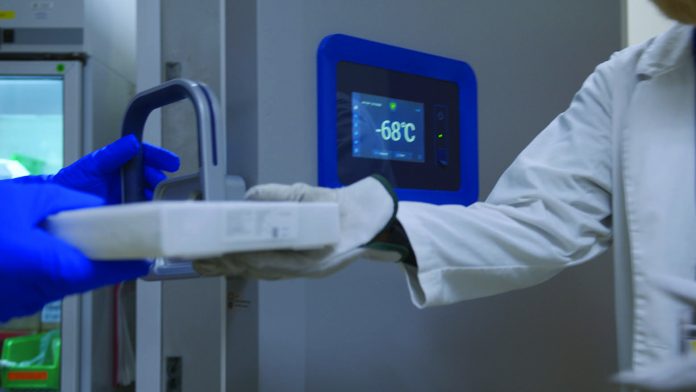By Carol Vaughn —
A Riverside official spoke about the COVID-19 vaccine in a virtual town hall Monday, Dec. 21.
Riverside Health System received and began to distribute doses of the Pfizer vaccine in December. The first dose was administered at a Riverside facility Dec. 16.
“It was a very exciting time for us,” said Cindy Williams, vice president and chief pharmacy officer for Riverside.
Since then, the FDA issued emergency use authorization for a second vaccine, made by Moderna.
Williams in an emailed statement said Riverside received its first shipments of the Moderna vaccine Dec. 22.
“We are currently continuing to administer the Pfizer vaccine to healthcare workers this week, but the Moderna vaccine will be used for our scheduled healthcare worker clinics over the next two weeks,” she said.
Both vaccines require two doses to be fully effective.
The second dose should be administered 21 days after the first for the Pfizer vaccine and 28 days for the Moderna vaccine, according to Williams.
“It’s important to get the same vaccine for both doses,” she said.
Riverside is giving patients who receive the first dose a card with information about the vaccine and a reminder of when the second dose is due.
The Centers for Disease Control recommends people make a photograph of the card with their cellphone as a reminder in case the card is misplaced.
After a person is vaccinated, they are monitored for at least 15 minutes, or at least 30 minutes for anyone with a history of severe allergic reactions, with medications and monitoring equipment in place to treat a reaction.
Neither vaccine has egg-related components.
Williams spoke about the vaccines’ safety, efficacy, and side effects.
“What we’ve seen in the clinical trials information is that the efficacy of the vaccines and the safety of the vaccines is very similar; but as with any vaccine, there is always a chance of side effects,” she said.
Most trial participants reported generally mild to moderate side effects with both vaccines — most commonly injection site pain, fatigue, headache, muscle pain, joint pain, and, rarely, fever.
How long the vaccine provides immunity is still being studied in clinical trials, according to Williams.
“What we know as of now, based on when the first Moderna and Pfizer vaccines were administered back late last spring, is that we’re roughly six months into the post-vaccine monitoring for those initial recipients of the vaccine,” Williams said, adding the FDA will continue to follow those people for at least two years.
One frequently asked question is about the phases of vaccine distribution, Williams said.
Several groups at the national level put together guidelines late last summer.
“This was done because we knew initially when the vaccine was approved there would not be adequate doses for everyone to get vaccinated at the same time,” Williams said.
The Advisory Committee on Immunization Practices of the CDC is tasked with recommending who gets vaccinated in each phase, based on risk level “as well as the importance of individual roles in supporting the functioning of society,” Williams said.
The nation currently is in Phase 1A, with healthcare workers and older adults living in long-term care or assisted living facilities prioritized.
When the ACIP met Dec. 20, the goal was to determine the next two phases.
The committee decided Phase 1B will include people age 75 and over not living in congregate settings and frontline essential workers — including police, firefighters, teachers, daycare workers, U. S. Post Office employees, public transit workers, food and agriculture employees, manufacturing, and grocery store workers.
The next phase, Phase 1C, is recommended to include people age 65-74, younger people with high-risk health conditions; and other essential workers, including in transportation, food service, construction, finance, IT and communication, energy, media, legal service, public safety, and water and wastewater services.
The ASIP will continue to evaluate information on the virus’ impact and make recommendations about future phases based on that.
Williams said it is anticipated everyone will have access to receive the vaccine by sometime in the summer, depending on more vaccines being approved and manufacturing capacity.
“Riverside is currently following state and federal guidelines, and as those are being firmed up by the state and CDC, Riverside will continue to update the community on next steps,” Riverside spokesperson Savannah Lentz said.
UPDATE: Eastern Shore Cases and Outbreaks
The Eastern Shore Health District reported, between Dec. 21 and 28, 158 new cases, five hospitalizations and zero deaths in Accomack County and 39 new cases, zero hospitalizations, and zero deaths in Northampton County, according to the Virginia Department of Health website.
The district reported 36 visits to the emergency department for COVID-like symptoms the week ending Dec. 19 and 32 emergency department visits the previous week. The numbers do not reflect confirmed cases but help track the burden on local hospitals.
Accomack County currently has one outbreak in progress, at Shore Health and Rehabilitation in Parksley, where 59 cases were reported as of Friday, Dec. 25.
Between zero and five deaths related to the outbreak have been reported. To protect anonymity, if between 0 and 5 deaths are associated with an outbreak, the count is represented by an asterisk.
The numbers only include cases linked to the outbreak. If someone tests positive for COVID-19 but their exposure was determined to be outside of the setting and they did not pass on the virus to anyone in the facility, the case is not reported on the health department’s outbreak dashboard.
Northampton County as of Dec. 25 had one outbreak pending closure, at Occohannock Elementary School, where the health department was notified of an outbreak on Nov. 28 and there were eight cases reported.
Pending closure means 28 days have passed without a documented new case and the outbreak has not yet been closed in the reporting system. The status refers to the outbreak investigation pending closure in the Virginia Outbreak Surveillance System, not the facility itself closing.
Outbreak numbers are updated weekly, on Fridays, on the Virginia Department of Health website, at https://www.vdh.virginia.gov/coronavirus/covid-19-data-insights/covid-19-outbreaks-by-selected-exposure-settings/
The dashboard includes information about outbreaks in medical care facilities, residential or day programs licensed by the VDH, the Department of Social Services, or the Department of Behavioral Health and Developmental Services, summer camps, and K-12 schools.



